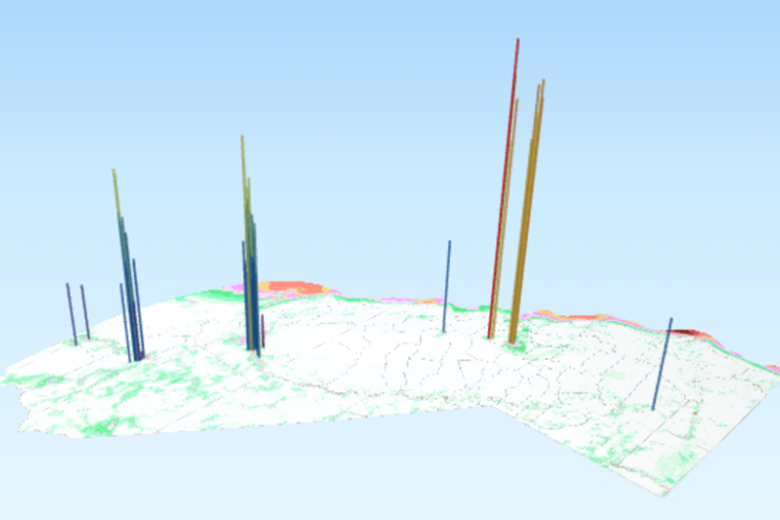Columns at the project locations are scaled and shaded so the height and color represent the CF of the project. (Capacity factor is the ratio of the energy produced to the amount that could ideally have been produced in the same period.)
Projects are plotted on a base map that depicts wind resources across the state, and a legend shows the wind speed classes. The base map shows resources at 70 m height; new commercial-scale wind turbines are typically designed for at least this height. As technology improves, greater resources become available at taller heights. Wind power is proportional to the cube of the wind speed. A doubling of wind speed at the rotor results in an eight-fold increase in wind power. County boundaries are also shown on the map for reference.
Renewable energy resources have a size and geographic distribution within each state. Planning and land use constraints limit how much of and where these resources are used, and energy generation is limited by national, state, and local policies. Two examples are the DRECP and the RETI.
By exploring the visualization, a viewer can gain a three dimensional understanding of seasonal variation in generation CFs, along with the locations and distribution of generation projects. Moving through the 3-D space gives a conception of generation CFs across the state. The viewer can observe that most projects peak in the summer months, although a few peak in the winter. The large range in CFs is also apparent.
The base map shows wind speeds for part of the offshore areas, which contain much larger wind resources than the resources over the land areas. Currently, all California wind projects are on land. Estimates for capacity factors of hypothetical offshore wind projects can also be displayed using a switch on the map. The values displayed for offshore projects are for a typical year, whereas the values shown for land-based projects are historical values from particular years. As with energy resources on land, making use of the offshore resources is limited by planning and area use constraints.
Values displayed are subject to revision when more accurate data is available. Data analysis and visualization is by Energy Commission staff. Base map is by AWS Truewind. For further information, see contact

Seasonal Variation in California Wind Generation
The map is best viewed using the current versions of Chrome and Firefox web browsers. If using Internet Explorer, be sure Compatibility View is turned off. If you have trouble viewing the map content, contact us, and we will provide the information in an alternative format.
The 3-D map can be rotated, tilted, and panned using the buttons of the mouse and zoomed using the mouse wheel. The display is an animation that steps from one month to the next, either forward or backward in time. Controls allow the viewer to switch features of the display, including the month and year and the animation speed and direction. Clicking on a single generator column displays a table of values. CFs are shown in decimal fractions in the table. The number of turbines represents the latest quarter that turbines were available to generate at the plant.
Data last updated: December 7, 2022
Data Collection Information
Data is collected primarily through the Wind Generation Reporting System of the CEC, with some supplemental factor information.
Citing
Please cite use of these data and images. California Energy Commission 2022. Visualization of Seasonal Variation in California Wind Generation. Data last updated December 7, 2022. Retrieved March 8, 2023 from Visualization of Seasonal Variation in California Wind Generation.
